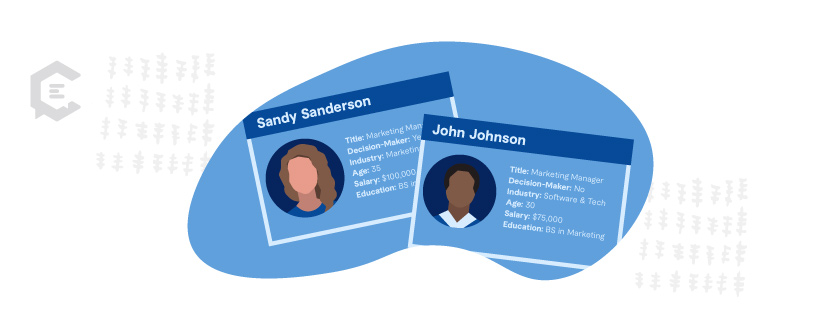For your content to be meaningful, you need a content mission and vision that support your company’s overall mission and vision statements. Your efforts should also align with corporate values and business goals.
That’s all well and good in theory, but how do you actually accomplish this? How do you set the right goals for your content?
That’s what this post is about.
How to Align Your mMission and Vision with Goals
Your content strategy should address your business goals, identify buyer personas, and meet your target audience’s needs while supporting the content mission and vision. Sounds like a lot, but let’s break it down into a series of questions:
- What are your mission and vision?
- Who are you trying to reach (buyer personas)?
- What business goals will you address with your content?
- What are your content objectives?
Here’s an example. Let’s say you’re in charge of content for a company that makes portable monitors. The primary product is an additional (second) detachable laptop screen for people who travel for business or work off-site. Just for fun, let’s call the company Double Vision.
Content vision
Double Vision wants to free people from their desks so they can pursue life beyond the office while maintaining productivity.
Content mission
Double Vision provides business travelers and remote workers with advice on using technology and tools to improve the work-away-from-the-office experience.
Personas
Business travelers (sales reps, entrepreneurs, consultants) and people who work off-site or from home.
Business goals
- Increase orders by individuals by 30 percent.
- Develop a pilot program for volume buying for teams and secure three major accounts of 10+ users.
Content objectives
- Demonstrate how Double Vision’s portable and attachable second monitor improves productivity and efficiency for laptop users when on the go or working outside of the typical office environment.
- Help business travelers and remote workers select technology, hardware, and other tools to optimize work away from the office.
- Give advice and support to off-site and traveling workers to help them connect and stay visible with coworkers and colleagues while working remotely.
Put all of this into a content strategy statement that supports your mission and vision.
Double Vision produces content to increase individual orders by 30% and help establish a volume buying program for major accounts (10+ users) in 2017. We will achieve this by providing useful and educational content that helps business travelers, individuals who work from home, and other remote workers stay productive and effective outside of the office environment.
Now you’ve got a content strategy statement to keep Double Vision aligned to vision, mission, and business goals.
You can create a content strategy statement for each major business goal, for departments you support (example: helping HR build an employer brand), by the campaign, or by channel (social media, blog, etc.). Just remember that these are just content strategy statements. Go deeper to build a full content strategy.
Develop Your Editorial Calendar
With your mission-and-vision-supporting content strategy statement in hand, you can work with your content team and other contributors to build your editorial calendar. Brainstorm — individually or in a group — all the topics that fall within the parameters of your strategy statement. Score your topics on a scale of 1 to 5 to whittle down the list to the best options.
Next steps:
- Determine the best format for each topic: Blog post, webinar, video, social post, podcast episode, Instagram reel, TikTok video, etc.
- Select the right approach: Are you creating branded content, a content brand, or an extension of your culture through content?
- Define how to distribute each piece of content: Email blast, social posts, syndication
- Identify the appropriate promotion options: Paid social, PPC, native advertising, influencer campaigns, employee advocacy
- Outline technology and resource requirements: including other staff members and freelancers, along with associated costs
- Get your budget approved: Be prepared to back up your budget by showing how your plan will help the company achieve business goals)
Finally, get your content scheduled. Make sure that all of your contributors have access to the calendar, so everybody’s aware of deadlines. Track who is responsible for creating, editing, distributing, and promoting each piece of content.
Choose and Track Your Content KPIs
Before you publish and distribute content that supports and highlights your brand’s mission and vision, select the right key performance indicators (KPIs) to measure effectiveness. Here are a few to consider based on categories of business goals:
Awareness and branding
Awareness and branding metrics aren’t always easy to pin down. Here are a few suggestions.
- Monthly branded search volume
- Organic search visit metrics
- Total press releases and pitches accepted by media and industry blogs
- Number of social media mentions
- Surveys and focus group data to measure content & campaign effectiveness
Sales and marketing
There is likely a revenue target but monitor these metrics, too, as they can impact the likelihood of achieving the revenue goal.
- Traffic metrics (website, app visits, or foot traffic at physical location)
- Email open and click rates
- Lead generation data
- Marketing qualified leads data
- Sales qualified leads data
- New business growth
- Customer retention (including satisfaction survey data) and organic growth
Talent retention and recruitment
Measure before and after results on employer branding or culture-building initiatives that your content may support.
- Employee turnover
- Employee referrals
- Employee advocacy/social mentions
- Number of new applicants through social media or search
- Staff participation in company events
- Open & click through rates on internal newsletters
Track your KPIs monthly (or more often if needed) to measure your effectiveness. If you aren’t hitting your content and corporate goals, it’s time to adjust your approach.
Create a Content Strategy that Supports Your Mission and Vision
As you can see, there’s a lot more to content than creating content. We’ve hit on a program’s key components that align mission and vision with content goals. With these tips in mind, treat your content program as a business in and of itself. Document vision, mission, strategy, values, and goals. Measure, analyze, and improve your content.
And if you want some extra help, ClearVoice has your back. Our expert creators are ready to help you produce content that drives your company’s growth and success. Talk to a specialist today.







